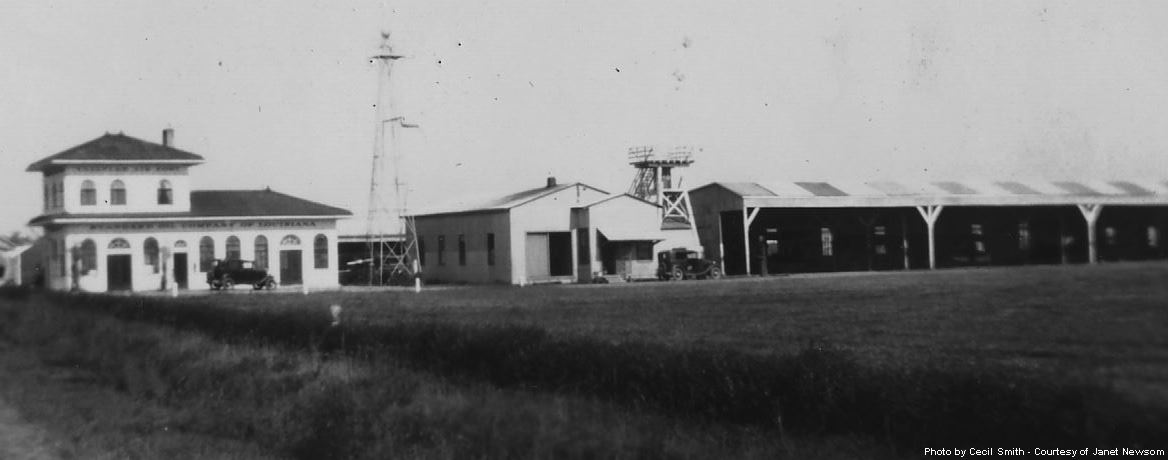History of Tallulah
Airport
From
1930 Madison Journal Article
(Courtesy
of E. Cecil Smith Scrapbook and Janet Byram Newsom)
Tallulah Established
First Airport in Louisiana
Cotton Dusting
Experiments Give Stimulus To Notable Enterprise
Landing Field Equipped With Modern Devices for Day and Night
Flying; Beacon Light, With Range of 45 Miles, is Feature of Plant; Base for
Delta Laboratory

Tallulah boasts the
first municipal airport in the state of Louisiana. This was made possible
through the co-operation of the Delta Laboratory of the United States Bureau of
Entomology, which in 1922 established the port to experiment with the use of
airplanes for cotton dusting. The use of the field, without charge, was extended
to ships of every class, and has been the medium of much publicity for the
town. Courteous service, combined with the accurate and detailed information
available from the meteorological observatory on the field has brought the port
to the attention of pilots, and Tallulah is known everywhere among fliers.
Here have been
carried on some of the most spectacular experiments in the history of aviation,
resulting in the perfection of the most effective method ever developed of combating
the boll weevil and other insect pests known today.
Located two and a
half miles from the center of the town, on a paved and graveled road, the
airport is easily accessible to Tallulah.
The landing field
covers an area 3400 feet by 1400 feet, but is in the midst of a clear level
tract of land a which is maintained only as a pasture by
the Scott estate, on whose property the airport is situated.
$100,000 Expended
A sum exceeding
$100,000 has been expended in construction and equipment of the airport, and of
this Madison parish and Tallulah have contributed a small portion for drainage
and grading. There is a hangar with space for eight planes, machine shops, a
splendid service station, and the meteorological observatory located on the
field.
It was developed out
of the need for accurate and technical weather facts in carrying on the laboratory
research into the lives and habits of destructive insects, but it has served to
furnish more complete information to pilots than is available at other fields.
The chief meteorologist and his assistant, I. W. Tate, through their training
and the extensive scientific equipment of the observatory, are enabled to make
up a daily map of weather conditions at 78 other ports in the United States and
Canada. Four wind aloft readings are taken every day
and at night when the department planes go up.
High-powered Beacon
A Standard Zenith airway
beacon, on a 51-foot tower and revolving six times every minute, can be seen
for a distance of 45 miles from the field. A 10 k. w. floodlight and border
and obstruction lights insure a minimum of safety in night flying from this
port.
Two expert mechanics
and four helpers are in attendance for emergency service, and three
electrically operated service pits strategically located make it possible to
care for six airplanes at one time.
A contract for
carrying mail was recently awarded by the United States Postoffice
department to a commercial line operating through a Tallulah although as yet
the town has not been officially designated as an airmail stop. It is expected,
however, that Tallulah will be eventually a named as one of the stops. This was
predicted by General McCormick in an address made at the dedication of the
Mississippi river bridge at Vicksburg a few months
ago.
Army Pilots Preferred
In the work of the Delta laboratory airport,
when it was first established, in the early days of dusting experiments, army
pilots were detailed to the port, but during the past five years civilian
pilots have been employed. However, recognizing the superior training given in
the army, only army trained men are used.
George McGinley, chief pilot, was
first stationed at the field while a lieutenant in the United States air service,
and later resigned his commission to return to the Delta Laboratory. He is a
native of Nebraska and has been flying since 1919.
J. F. Payne, a native
of Natchitoches. La., has been at the field for five
years. He received his training at Brooks and Kelly Fields, and was engaged in
commercial dusting before coming to the Tallulah field.
R. G. Long, chief
airplane mechanic, is also a rigger and parachute packer. He served in the
army during the World war and left the air service in 1925 to come to the Tallulah
airport.